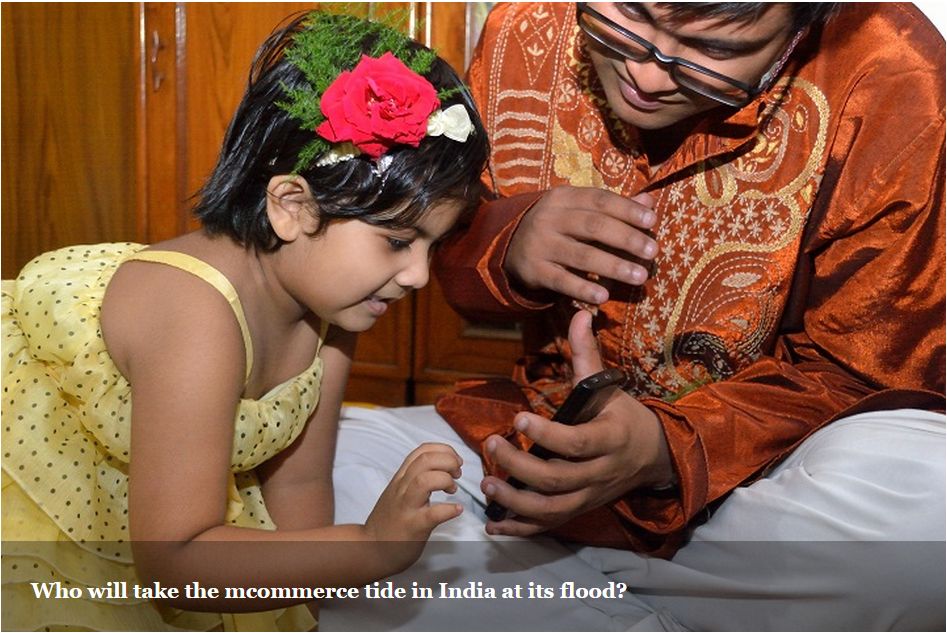
From payment facilitators like FreeCharge and Atom to online marketplaces like Flipkart andSnapdeal, ecommerce companies in India are seeing a rapid increase in mobile traction, and are figuring out ways to address this mobile-first market. But the user experience is still far from hassle-free, compounded by mobile-unfriendly payment gateways and language barriers.
FreeCharge is a case in point. It’s an online facility which allows users to recharge their prepaid mobile phones, direct-to-home satellite television connections, or data cards instantly, and rewards them with discount coupons. Until December last year, only five percent of users accessed the facility from their mobile phones. Today 70 percent of the transactions on FreeCharge happen on a mobile platform.
Alok Goel, the former chief operating officer at ticketing site redBus.in, who is now the CEO of FreeCharge, says that as soon as its mobile platform was streamlined, users shifted en masse. “This shows the hunger among consumers for good mobile products to conduct ecommerce transactions. Mobile transactions on the FreeCharge app have grown 30 times since January. Seventy percent of our transactions come from mobile platforms and we are growing more than 400 percent year-on-year,” he told Tech in Asia.
But when FreeCharge streamlined its mobile platform, it faced a Hobson’s choice: expose its users to banks which were out of sync with the mobile world or exclude some banks from its payment options. He said:
“We had to leave out quite a few in the end, because many banks just don’t have mobile-friendly payment gateways in India.”
Brick-and-mobile model
Despite such hitches, the shift to mobile is inexorable. Even a primarily brick-and-mortar company like Titan, which sells jewelry, watches, and eye wear, is getting its mobile act together. A responsive design for mobile phones and tablets has resulted in 15 percent of Titan transactions moving to those platforms, according to Alokedeep Singh, head of ecommerce business at Titan Industries. “This year there has been a leap from browsing to actually completing transactions. Mobile traction for even a touch-and-feel product like jewelry shows the formidable opportunity in this space,” he said during a recent panel discussion in Bangalore.
Homeshop18.com started a mobile commerce division two years ago “because we realized we need to be where our users are,” said Vikram Dasu, ecommerce head at the online marketplace. This had resulted in a ten-fold increase in mobile shoppers for Homeshop18.
The country’s biggest ecommerce sites are reporting similar trends. Snapdeal says more than half its sales now happen over its mobile platform. “With increasing consumption of data on mobile phones, we think that the next wave of digital commerce customers will come from this medium,” Snapdeal vice president (product management) Ankit Khanna said.
Last year, mobile data traffic doubled in India and Southeast Asia, according to mobile ad exchange Vserv.mobi. Nearly a third of the traffic on ecommerce sites came from mobile in 2013, and this could cross the two-thirds mark this year.
Flipkart co-founders Sachin and Binny Bansal expects the country’s largest online retailer to be largely an mcommerce company in a couple of years.
“India is at an inflection point right now. In a couple of years, 500 million people from all over the country will get online through their mobile phones. Shopping will have to be very different then. This funding is all about making it happen,” Sachin Bansal said when announcing US$1 billion of funding in August. “Twelve months ago, just five percent of our revenue came from mobile shoppers. Now, 50 percent of our shoppers are mobile users,” he added.
So it made good business sense for Flipkart to focus more on improving mobile payments for its customers. It recently invested in mobile payments startup ngpay (Next Generation Pay) and is phasing out their own payments product PayZippy.
Language barriers in the hinterland

Internet-enabled low-cost phones are fueling this trend, especially in rural India. eBay India MD Latif Nathani sees mobile traction growing outside the metros as a result. Nearly a third of eBay India’s traffic comes from mobile devices, according to him. eBay has also upped its stake in Indian ecommerce marketplace Snapdeal this year, encouraged by smartphone and internet trends.
The sheer numbers of mobile devices as well as their mind-boggling variety pose a challenge too. “There are over 4,000 different devices that we need to cater to. Optimizing a website over such a broad range of technical requirements is no easy task,” Snapdeal VP Ankit Khanna says. Besides, broadband speeds vary widely, which adds another layer of complexity.
There is also a language barrier to contend with in many places. A multitude of regional languages in second- and third-tier cities, where English usage is limited, pose a unique challenge in India. Alok Mehta, chief technology officer of payment solutions provider Atom, says implementation of their platform in local languages is a priority. “Once localization happens, mobile commerce will overtake e-commerce,” he told Tech in Asia on the sidelines of an etailing India conference in Bangalore recently.
A 186 percent year-on-year growth in smartphone shipments in the first quarter of this year, as reported by IDC, clearly indicates that the demand from mobile users for better services and products will not be denied. Whether it’s a bank or an online retailer, they can no longer afford to be out of sync with the mobile generation. The smart players in the market have already adopted a mobile-first approach, and some are even going for a mobile-only play.
According to the latest report from Gartner, mobile connections in India will grow to 815 million in 2014, an eight percent increase from 755 million connections in 2013. The mobile services market in India will remain almost at the same level as 2013 at $19.2 billion in 2014.
From mobile-first to mobile-only
Paytm for one is seeing value in putting the cart before the horse. While the ecommerce biggies first developed their websites before thinking of mobile derivatives, Paytm started with a mobile commerce platform. To the Delhi-based startup, the website is secondary.
This is more than a shift in priorities; it is a fundamentally different way of thinking about customer needs, user behavior and platform features. Paytm founder Vijay Shekhar Sharma explained to Tech in Asia:
“A problem with web commerce is that there is a funnel and a screen which is so big that to buy something, you have to go through several steps before you can check out. You end up clicking five to seven times after you decide what to buy. On the mobile, this is lethal, criminal. People on their mobiles need the least amount of touches on their smartphone touchscreens to get out. At Paytm, we have features that fill the home address automatically, show up profiled payment details, etc. and most importantly, a two-click checkout.”
The mobile-focused strategy is paying off big time for Paytm. Consider these numbers:
- 10 million orders were placed through Paytm in July, more than twice the number in July 2013. Currently, they are handling more 430,000 orders a day.
- The gross merchandise value (GMV) of Paytm’s transactions was US$17 million in June 2014 – that’s two-and-a-half times the GMV recorded in the corresponding month of the previous year.
- There are over 14 million registered users on Paytm, and nine million of them came on board in the last 12 months.
According to Juniper research global mcommerce via tablets and mobile phones hit US$1.5 trillion in 2013, and is expected to exceed US$3.2 trillion by 2017.
Dr Windsor Holden, author of the report, pointed out: “A significant minority of retailers have yet to optimize their sites for mobile. Unless retailers ensure a seamless, user-friendly mobile shopping experience, they will fall behind competitors who are already using mobile channels to enhance customer relationships.”
Mcommerce spending has already reached such a critical mass that retailers must address this new market dynamic or lose competitive advantage. They simply have no choice but to dramatically change their way of functioning. The leaders in the space have found ways to tackle usual retail challenges like clunky check-out lines, bad customer service, and lost selling prospects on mobile. From personalization and retargeting to loyalty programs and faster checkout processes, the opportunities for a technology play are countless.

250 million internet subscribers
The rapid rise in smartphone usage is what makes India the fourth fastest growing B2C ecommerce market in the world, according to a paper just published by research firm yStats.
The report says India’s mobile shopper penetration ranks fourth among all the countries in the Asia Pacific region. And this trend can only accelerate.
The potential for growth can be gauged by the fact that India now has nearly 250 million internet subscribers – second only to China – according to the Internet and Mobile Association of India (IAMAI). What’s more, nearly four-fifths of the 1.2 billion population are yet to get online. And even among those accessing the internet, only about 10 percent are shopping online. But now, with affordable smartphones in the hands of the masses, the number of online shoppers is projected to double in the next three years – and most of these will be mobile shoppers.
The roll-out of 3G and 4G services helps bolster this trend, as does the availability of digital wallets. To many online shoppers in second-tier cities who are not so comfortable with net banking or credit cards, wallets are a great enabler. Paytm alone has a digital wallet user base of 8.5 million.
Telecom operators too have come up with digital wallets – Airtel Money and Vodafone M-Pesa – which allow users to deposit small amounts and use them for subscriptions, bill payments or online retail. More than a third of internet subscriptions in rural India are mobile-only, and many of these subscribers don’t have bank accounts.
More time spent on phones than TV
User behavior points to the way ahead for mobile commerce. An Ericsson ConsumerLab survey across 18 Indian cities between April and June this year found that people are now spending more time on their smartphones – three hours and 11 minutes a day on average – than in front of a TV – two hours and eight minutes. Users are spending 20 percent more time on their smartphones than they did two years ago, and a quarter of them reach for their smartphones more than 100 times a day. Combine that with a smartphone user base of over 100 million expanding rapidly and you can see why every ecommerce player wants to get their mobile act together.
“There is a tide in the affairs of men, which, taken at the flood, leads on to fortune,” wrote William Shakespeare centuries before the arrival of the smartphone wave in India. But the advice contained in that immortal line is exactly what is guiding smart moves to mcommerce.
From payments to marketplaces and app-based services, mcommerce represents the biggest opportunity for retail innovation currently – and one of the hottest testbeds for it is India. Those who understand user behavior and requirements, and emergence of new technologies, will be the ones who take this tide at its flood and make a fortune.
Find out more: https://www.techinasia.com/mobile-commerce-startups-in-india/




